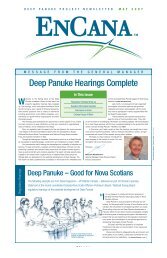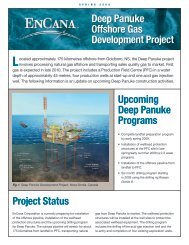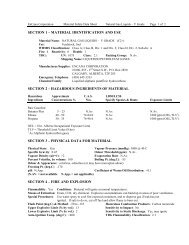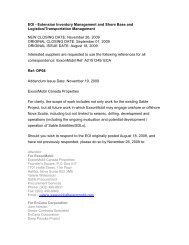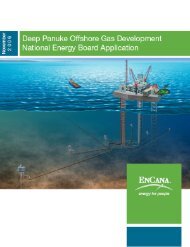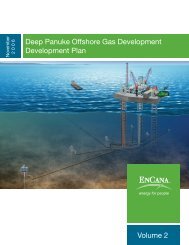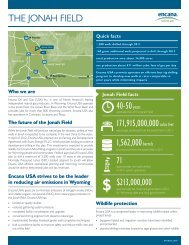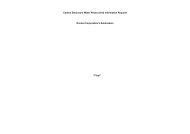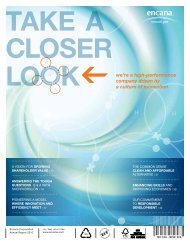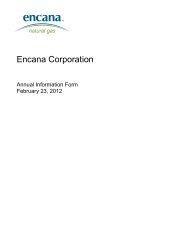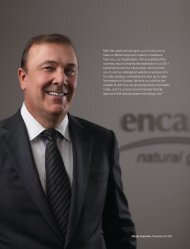Deep Panuke Project Description - Encana
Deep Panuke Project Description - Encana
Deep Panuke Project Description - Encana
You also want an ePaper? Increase the reach of your titles
YUMPU automatically turns print PDFs into web optimized ePapers that Google loves.
Flaring acid gas consists of directing the acid gas stream to a flare system for incineration and emissionto the atmosphere. Flaring is a relatively low-cost option and is widely used for this type of acid gas.There are SO 2 emissions resulting from the incineration process, which while permissible, can impact airquality. In this case the amount of SO 2 released is within air quality guidelines. This alternative was notruled out, but was considered less preferable than acid gas injection, where economic and operable.The seawater scrubbing option consists of an incinerator and a scrubber. The unit accepts acid gas from theincinerator that has converted the H 2 S to SO 2. The SO 2 is subsequently removed by seawater absorption ina packed column. The acid gas leaving the incinerator flows up the column contacting the seawater countercurrently. The spent seawater flows by gravity to a mixing device, where it is combined with other plantdischarge water (cooling water, produced water, etc.) and returned to the ocean.Seawater scrubbing technology has been used in some onshore facilities such as power plants, but hasvery limited experience in offshore applications. Two offshore applications were identified, and bothinstallations do not have established performance records. Further, an environmental review of thistechnology performed in 2002 identified that the discharge stream would likely be considered to bedeleterious to marine life. Further recent investigation has found that equipment vendors are no longeroffering this type of equipment. The seawater scrubbing was rejected on the basis of being a technicallyunproven and unacceptable alternative.Offshore sulphur recovery was considered as an alternative for acid gas handling. After preliminaryreview of the option, it was determined that it was not economically feasible due to the size of theplatform required for the process and the logistics of handling the sulphur product.2.10.2.8 Produced Water DisposalEnCana identified four potential alternatives for produced water disposal on the <strong>Deep</strong> <strong>Panuke</strong> <strong>Project</strong>.These alternatives were treatment and discharge overboard, injection into a dedicated well, simultaneousinjection into the condensate/acid gas injection well, and injection into the annular space of an existingwell. Each alternative carries different types and levels of risk to the <strong>Project</strong> (further informationprovided in Table 2.13). After a thorough review of the alternatives, the treatment and dischargeoverboard option was deemed the best technical and commercial option.Discharge OverboardTreatment and discharge overboard is a proven technology that is used world-wide in offshore oil andgas facilities, including offshore Nova Scotia. The treatment technology proposed for the <strong>Project</strong> willensure that the prescribed CNSOPB limits for produced water discharge are met or improved upon.<strong>Deep</strong> <strong>Panuke</strong> Volume 4 (Environmental Assessment Report)• November 2006 2-72




